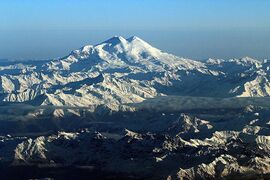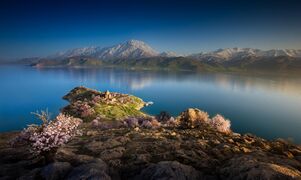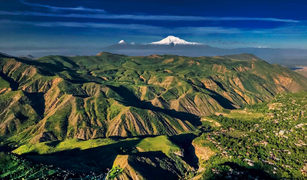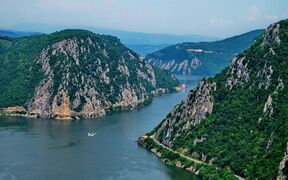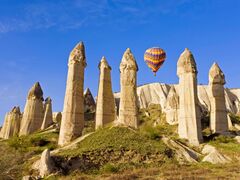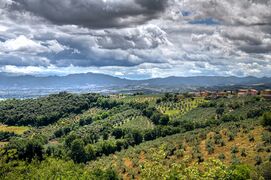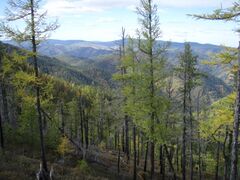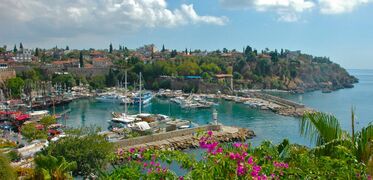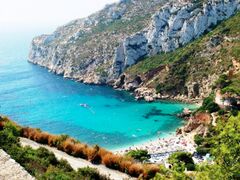Mesogeia
Empire of Mesogeia Βασιλεία Μεσογεια | |
|---|---|
Motto: "Dei Gratia imperator boleti proceritas" (Mesogeian Latin) "God's Grace Aids the Emperor!" | |
Anthem: God Save Our Empress! | |
| Capital | Alexandropolis |
| Official languages | Mesogeian |
| Demonym(s) | Mesogeian |
| Government | Federal republic with a semi-autocratic monarchy |
• Empress | Elena II |
| TBD | |
| Legislature | Parliament |
| Senate Imperial Boule | |
| Chamber of Poleis Chora Assembly | |
| Area | |
• | 843,360 km2 (325,620 sq mi) |
| Population | |
• 2020 census | 85,326,490 |
| GDP (PPP) | 2020 estimate |
• Total | $1.754 trillion |
• Per capita | $20,560 |
| GDP (nominal) | 2020 estimate |
• Total | 1.601 trillion |
• Per capita | $18,765 |
| Gini (2018) | high |
| HDI (2020) | high |
| Currency | Mesogeian Drachma (₯) |
| Date format | dd.mm.yyyy |
| Driving side | right |
| Calling code | 31 |
| Internet TLD | .MES |
Mesogeia, officially known as the Empire of Mesogeia is a sovereign nation, located in Ajax on the subcontinent of Alcaeia, the easternmost portion of the continent of Belisaria, sharing a western border with PLACEHOLDER. Mesogeia name means the "middle land", and it is often known as "The Middle Kingdom" implying the long held belief of Mesogeians that Mesogeia was the center of the world. The Mesogeian empire comprises an area of 843,360 km2 (325,620 sq mi), with an estimated population of 85 million people.
The Empire of Mesogeia is considered to be an absolute monarchy by tradition, while in practice it is federal parliamentary republic presided over by a nominally constitutional monarch. The current monarch is Empress Elena II, who as reigned since 1962, making her one of the longest reigning monarchs in Mesogeian history.
Mesogeia's capital and largest city is Alexandropolis; which is also a major political, cultural, and economic centre. Other major urban centers include Pharopoli, Troiana, Chrysopolis, Aithias, and Farsargadae. The official language is Mesogeian Hellenic which is spoken at the Imperial Court alongside Latin, while various other languages are spoken regionally including Farsian and Scythian in the central and eastern regions; Araratian, Anatolian in the southeastern coastal regions; Albanian, Colchian, Lazic, further north; and Pharosian, in the southernmost region of the empire. In addition to this French, English, Italian, and other western languages are spoken in major metropolitan areas.
Mesogeia is a developed country with a large and diversified economy. The Empire of Mesogeia has a high quality of life, and high living standards. Mesogeia is a regional power with notable cultural, diplomatic, economic, military, political, and scientific, influence. Mesogeia is home to one of the oldest civilizations in the world. As a result of its rich cultural history, Mesogeia is the site of close to 50 world heritage sites.
The country has been critized however for a number of reasons, including but not limited to its eastern and western culture clash particulary its fusion of eastern absolutism and western democratic principles, the perceived favoritism of Hellenic culture over others in the government, social inequality and a significant wealth gap, the church's role in government, perceived decadence, the extreme complexity of its bureaucracy and Imperial court, in addition to a reliance on the nobility and members of the social elite and upper middle class to fill the governmen.
Etymology
The origins of the name of Mesogeia are several centuries older then the country itself. The exact origin of the term Mesogeia is shrouded in mystery dating back at least six thousand years. Legends state that the original inhabitants believed Mesogeia to be the centre of the world proclaiming it to be the middle land or Meso gei, as it became known. Eventually the area settled by the ancestors of the modern Mesogeians became known as Mesogeia.
History
Prehistory
The earliest archeological evidence in the territory that is modern Mesogeia is dated to about 2.1 million years ago. In the early twentieth century archeologists discovered the remains of the oldest recorded hominid to reside in what is now Mesogeia, in a cave in the modern province of Pharosia.
The hominid fossils of a Homo Erectus were discovered in the central province of Mesaia, archeologists have even dated between 710,000 and 830,000 years ago. Meanwhile in the region of what constitutes the modern province of Morea the remains of Homo sapiens were unearthed (dated to 250,000 and 125,000 years ago). Several hunter gather societies are attested between the 14th and 9th millennia BC living around the major waterways of the region. The earliest established settlements in Mesogeia are dated to this period.
Between the 9th and 4th millennia BC, a wide range of changes occurred in which the largely hunter-gather societies of Mesogeia transitioned into agricultural society residing in settled towns and later cities. In the 9th millennia BC, the domestication of dogs, pigs, goats, and sheep occurred. In the succeeding millennia in Mesogeia archeological evidence suggests that agricultural produce such as wheat and barley. In the 7th millennia BC, cats were domesticated,. By the 6th millennia BC, cattle were domesticated, wine and cheese were first produced in the state. By the 5th millennia BC, agriculture was firmly established in central Mesogeia and was expanding; by the end of the millennia, beer and the wheel had been developed. By the 4th century BC an agricultural civilization was firmly established in what is southern and central Mesogeia. Mesogeian writing system originated in this period, as did several ancient Mesogeian states.
Ancient Mesogeia
For centuries the legends and history of Mesogeia have often been tied closely together. A unified state was established sometime around 2,500 BC, in southern Mesogeia. This semi-legendary kingdom was known as the Mesogeian dynasty which is said to have ruled for 1015 years. Named after its founder Mesogeius, the dynasty was believed to have been largely mythological until archological evidence was found in the 1700s dating back to their rule with inscriptions listing their kings on the walls of a long lost temple in southern Mesogeia.
In any case, Mesogeius I was said to be descended from the gods in a story related in the Mesogeian holy book, the Avesta which claims that Mesogeius arrived in ancient Mesogeia with his twelve sons Troianus, Anatolius, Dardanus, Farisus, Arartius, Isauris, Farasus, Saramatius, Paralius, Lazicus, Albus, and Gallus, after a seven month voyage.
Texts in the Avesta claim that the Mesogeians subjugated the inhabitants and declared overlordship over them who hailed them as kings. Modern historians have concluded that all modern ethnically Mesogeian peoples share a common gene, giving support to the legend of mesogeians being descended from one of the twelve sons of Mesogeius. The Avesta asserts that Mesogeius and his sons enslaved the previous inhabitants of the area, eventually eliminating them as an independent race.
Following the death of Mesogeius in 2475 BC, his line would rule central and southern Mesogeia for well over a thousand years, ruling longer then any other dynasty in the history of the Mesogeian monarchs. Like Mesogeius himself many of the early kings of the Mesogeian dynasty are considered to be legendary or at least semi-mythical with many legends and myths attributed to them. Several kingdoms existed besides the kingdom based in Memphis, but this kingdom known to modern historians as the Middle Kingdom or sometimes as the Sahen dynasty was arguably the strongest and most powerful.
Sometime around 1485 BC the ancient state based at Memphis collapsed and the region was plunged into a time of disunity known as the age of the warring states. This period lasted for approximately three centuries, only ending in 1179 when the Alcaeid dynasty was established at Chrysopolis. The Alcaeid dynasty was the first dynasty to take the title of Emperor; and it is from this period that the emperors of Mesogeia are generally dated. The Alcaeid empire expanded over the next several centuries to the point that by the late eighth century BC, most Mesogeian peoples, together with the "pre-unified Mesogeian" kingdoms, were all under the dominion of the Alcaeid Empire.
The great king Artaxsaca VII (known under the reign name of Alcaeus XXIX) reigning in the late eight century BC, had a profound impact on the history of Mesogeia. His policy of religious tolerance, his advocacy for basic humane principals shaped the empire for the next several centuries. The Alcaeid empire is notable for its use of an official language, national coinage, and a network of royal roads and postal system. The empire of the Alcaieds was unique in the fact that it was governed from four capital cities, Chrysopolis, Farsargadae, Sousa, and Ecbatana. The sixth century BC saw the Alcaeid empire's conquest of the Morean states. The assimilation of the Greek speaking Morean city-states in the north led to the eventual hellenization of the Alcaied state as a whole; this is evidenced in the hellenized Alexander IX who reigned in the 4th century BC. The centuries between the conquest of the Morean states in the sixth century BC and the accession of Alexander IX in the 4th century BC on the celestial throne are cited as the first golden age of Mesogeian culture. Five of the seven great schools of though developed between the 6th and 3rd centuries. Only PLACEHOLDER is older, dating to the 15th century BC.
By the 4th century the Alcaeid empire was not the only power in what is modern Mesogeia. The republican leaning Kingdom of Troiana having expanded across the region of Rumalia and western Mesogeia over the last two centuries eventually established itself as the most powerful state in the western half of modern Mesogeia. The first contacts between the Alcaeid Empire and its western neighbor were peaceful, but ultimately relations soured and the two powers fought successive wars over the next several centuries.
The Alcaeids would rule southern and central Mesogeia for several more centuries until the last ruler, Roxana VI died in 27 BC. Roxana is noted for her union with PLACEHOLDER, the king of Troiana. Western contemporaries at the time described the union as the triumph of the west over east or the republic over monarchy; while contemporaries residing in Roxana's realm described the union as a triumph over the west describing how PLACEHOLDER was defeated by the charms of a woman. Whatever the case, a large portion of what is now modern Mesogeia was firmly united upon that union.
Despite birthing several children by her union to PLACEHOLDER, the death of Roxana in 27 BC was followed by a civil war that nearly destroyed everything the Alcaeids had spent centuries building. Eventually in 21 BC, following several years of war Alexander (a reported grandson of Roxana), a Rumelian defeated PLACEHOLDER and declared himself Emperor of Mesogeia. Instead of ruling from his mother's capital, Alexander the great established the city of Troiana as his capital; the Troianians and Rumelian Republic having by then established itself as the most formidable of the successor states of the ancient Alcaeid empire. During Alexander XV's 40 year rule there was a flourishing of Mesogiean culture particularly in the area of art, architecture, and literature. During his four decades of rule, Alexander XV molded the Mesogeian state into an autocratic empire with the facade of a republic. After Alexander XV, the empire experienced two-hundred years of peace and prosperity. The empire established by Alexander XV was the progenitor of modern Mesogeiam, having left a lasting legacy on its government, military, culture, religion, laws, architecture, literature, and languages.
After Alexandr XV's death in 24 AD, his son Pausanias was made Emperor with the Senate approving it. One of his first acts as Emperor was to immediately repudiate his sister-wife Roxana Augusta who died that same year in exile likely from poisoning. Despite his paranoia, Pausanias early reign was a relatively peaceful one as he tried to immitate the just rule of his father that was until he descended into a life of dabachery and madness. The last five years of his reign are a stark contrast to his early reign and that the day to day affairs were left to his favorites as he spent more and more time in the palace harem in the company of his lovers.
Pausanias death in 39 AD was hailed by the general populace who had grown to hate and fear the incrasingly cruel and sadistic emperor. It is said that the army proclaimed his nephew General Alexander Drusus (later Alexander XVI Drusus) Emperor even as the old emperor lay dying in the palace. The Senate made no attempt to object to the army's demands and Alexnader Drusus became Emperor ushering in a new period of military expansion for the empire.
The expansion was only halted by his untimely death in 61 AD while on campaign after having reigned for 22 years. Having outlived two sons, his youngest son Meleager ascended to the throne as Emperor. Meleager married all three of his sisters, fathering several chidren by them and his concubines. During Meleager's reign of fourteen years he strengthened the powers of the emperor at the expense of the Senate and the other assemblies much to the joy of the people to the point that when he was assasinated in 75 AD, he was beloved by the people but hated by the nobility for his excesses. Meleager's death was the result of a palace coup orchastrated by senators angered at Meleager for his abuse of imperial power.
What followed was a systamatic execution of many of the immediate family members of the late Emperor, few survived except for his uncle Tiberius and a few minor family members. Tiberius I, being the younger brother Alexander Drusus had always lived in his brother's shadow being viewed by his family as a imbecile.
During his fourteen year rule, Tiberius I proved to be a capable ruler, administering the empire during a period of increased prosperity, he oversaw a reforming of the bureacuracy, military expansion north, east and west. While a capable administrator he failed to admnister his own household; the women of his harem schemed and plotted, one Empress plotted treason in his palace and was excuted while another his niece Cleopatra is said to have hastened his death through poison once he had decreed that her son Nero would rule after him bypassing his son Tiberius (who would rule as Tiberius II later on).
With Tiberius' death in 89 AD, his adopted son, Nero Meleager Caesar (the son of his wife and neice Cleopatra) ascended to the throne as Emperor, ruling until 102 AD. While Nero's early reign was noted for the advancement of cultural life and a few successful wars his extravagence and his implementing of heavy taxes on the wealthy earned him the hatred of the Mesogeian aristocracy which eventually led to his downfall and eventual death when they sided with Priscus, a rebellious noble from Asturia. The year 102 AD, witnessed the successive reigns of Priscus, Tiberius II, and Valerius I, all of whom meeting violent ends. This turmoil continued until Demetrius IV, a descendant of a cadet branch of the Trojan dynasty was declared Emperor by his army. Under Demetrius IV, the senate and the other assemblies continued to lose ground to an increasingly autocratic emperor, who filled them with subjects outside Troiana. In 112 AD, Demetrius V succeeded his father, being remembered for his successful crushing of the PLACENAME revolt. His early death in 114 AD, led to the accession of his brother Emperor Cassander I, who continued the autocratic practices of his father and brother much to the chagrin of the assemblies who eventually assasinated him in 129 AD. His cousin Nero became Emperor that same year. Nero II was forced to involve the Senate and the lesser assemblies in his rule, and his reign is noted for the restoration of liberties which had been restricted under his predecessor. His early death in 131 AD allowed for the smooth succession of his popular son Perseus I whose 20 year reign is best noted for his conquest of Dacia and Nabataia, his extensive building projects, and the implemention of social welfare programs that formed the basis of the later Mesogeian welfare state.
By the 3rd century however the military power of Troiana had declined so much that the empire was on the verge of collapse, with shrinking borders in the north and the east, The empire was surrounded by neighbors and foes alike which were like a thorn in the side of the Middle Kingdom.
The decline of the Empire of the Troianians was halted in the 4th century by the successful reign of Michael the Great who secured the empire's borders and established Mesogeian Apostolic christianity as the state religion of the largely pagan empire. The Troianian Empire managed to survive.
Medieval Mesogeia
Early Modern Age
Modern Age
Geography and climate
Geography
The Empire of Mesogeia covers a total area of 1,180,785 km2 (455,904 sq mi), of which 5.4% is water. The land of Mesogeia consists of a mainland and a few outlying islands near the coast. The highest point in Mesogeia is Mount Dios at 5,205m (17,076 feet). The geography of Mesogeia is characterized by mountain ranges along the coast and around the interior forming the Mesogeian highlands; with fertile valleys, and plains lying between them.
Climate
The climate of Mesogeia can be defined into two distinct categories, coastal and interior climates. The coastal regions of Mesogeia are characterized by a typically mediterranean climate. Some mountainous areas feature an alpine like climate contrasting with the typical mediterranean climate of the southern part of country.
A continental climate distinct from the mediterranean climate of the coast prevails in the country's interior, particularly around the Anatolian Highlands and Farsian Highlands, and Araratian Highlands, as a result of mountain formations around the coast. The climate of Mesogeia varies from region to region the more north you go, but typically most regions of the empire north of the Anatolian highlands have a particularly temperate climate.
Winters can vary across the country, but they are generally mild to cold and wet, with snowfall in the north and along the highest mountain ranges and plateaus. Summers can be hot and dry with frequent thunderstorms throughout the country. The highlands are generally cooler in the summer as a result of their high elevation. May is generally the wettest month of the year while July and August are the driest on average. The spring and Autumn months are more mild
- Landscapes of Mesogeia
Politics
The Empire of Mesogeia is classified as a federal republic, with a semi-autocratic monarch, but the country possess strong democratic traditions and principals. Whereas the Emperor (or Empress in the case of the current monarch) of Mesogeia is considered to be an absolute monarch with ultimate powers by tradition, she is however a constitutional monarch by law as a result of an un-codified constitution known collectively as the Constitution of Mesogeia.
While being a federal state the central government is based in the capital city Alexandropolis which holds supreme power in the land. Elena II is the reigning Empress and head of state, while Giannis Theodorou is the head of government as Imperial Mesazon.
Despite possessing strong democratic traditions and principles, a partially elected parliament, and being self-described as a federal republic, with a semi-autocratic monarch in name and tradition, the country has been particularly criticised for the confusing nature of its governmental system which has been depicted as authoritarian and despotic, due in part to the government's insistence of utmost respect and deference to the monarch above all. Mesogeian historians first coined the term "Republican Absolute monarchy in the 19th century to refer to the perceived union of autocratic and democratic ideals in the Mesogeian government. While foreign historians and critics have labeled it a benevolent autocracy at best or a fragile balance resting on the whims of a "good monarch" checked only by the threat of mass insurrection.
With one such critic claiming the nation as being on the verge of political turmoil, claiming that it was only a matter of time before the nation's various conflicting political forces turn on each other. While others have called into question the lack of major political upheaval in the last fifty years or so, citing the historic precedents of rebellions, revolts, and palace coups as an example of the country's perceived penchant for violant revolts. While others have incorrectly claimed that the Mesogeian tradition of Khvarenah (the hereditary dynastic imperial glory that divinely ordains successive monarchs) opens the door for violent rebellion.
Government
The government of Mesogeia is divided into three branches, the legislature, executive and judicial branches. The Mesogeian legislature is unique for being composed of four houses. The legislative power is vested in the tetracameral Parliament of Mesogeia. The parliament consisting of four houses; a Senate of appointed and hereditary nobles, the Imperial Boule consisting of appointed members of the clergy, the Chamber of Poleis and the Chora Assembly is composed of people respectively drawn from the urban and rural areas by general election
The Mesogeian parliament meets in the Palace of Magnaura, one of the oldest imperial palaces in the country. The Mesazon of Mesogeia is the head of government, while the monarch is head of state. The position of Imperial Mesazon generally goes to the leader of the party or coalition commanding a majority (this is however not always the case) of the seats in the two lower houses, the Chora Assembly and Chamber of Poleis. The Emperor ceremonially invites the leader of the majority to form a government.
The country two major political parties are the People's Party and the National Democratic Party, both parties having their origins in the empire's ancient chariot racing teams, the blue (Vénetoi) faction and the green (Prasinoi) faction respectively.
Military
The Mesogeian armed forces numbers some 379,300 active personnel along with 500,000 in the reserve forces. The armed forces of Mesogeia consists of three branches: the Imperial Army, Imperial Navy, Imperial Air Force
Administrative divisions
The Empire of Mesogeia is divided into twenty-five Satrapies. The twenty-seven satrapies are Dardanellia, Troiana, Morea, Epirus, Macedon, Thrace, Illyria, Dalmatia, Pannonia, Vlachia, Anatolia, Araratia, Colchis, Albania, Vantagallia, Taurica, Isauris, Phocaea, Pharosia, Cyrenaica, Khvarvaran, Khorasan, Transoxiana, Kushan, Ariane, Asturia, and Voreia-Peraia. The Satrapies are further divided into over 300 themata, which are further subdivided into 3,500 eparchia. The Eparchia are subdivided into over 10,000 municipalities, villages and communities known collectively as demos.
| № | Flag | Name | Native name | Capital | Area (km2) |
Population (31 December 2019) |
|---|---|---|---|---|---|---|
| 1 | File:FlagAlbania.png | Albania | Aghvania | Shirvan | X | X |
| 2 | File:FlagAlexandropolis.png | Alexandropolis | Dardanellia | Alexandropolis | X | X |
| 3 | File:FlagAnatolia.png | Anatolia | Anatolḗ | Angora | X | X |
| 4 | File:FlagAraratia.png | Araratia | Haykistan | Ani | X | X |
| 5 | File:FlagAsturia.png | Asturia | Asturias | Tarraco | X | X |
| 6 | File:FlagColchis.png | Colchis | Egrisi | Tiflida | X | X |
| 7 | File:FlagCyrenaica.png | Cyrenaica | Kyrenaika | Cyrene | X | X |
| 8 | File:FlagDacia.png | Dacia | Vlachia | Sarmizegetusa Regia | X | X |
| 9 | File:FlagDalmatia.png | Dalmatia | Dalmatia | Agranum | X | X |
| 10 | File:FlagMorea.png | Morea | Danaeia | Aithias | X | X |
| 11 | File:FlagEpirus.png | Epirus | Ḗpeiros | Dyrrhachion | X | X |
| 12 | File:FlagFarsia.png | Ariane | Fars | Fasargadae | X | X |
| 13 | File:FlagIllyria.jpg | Illyria | Illyrica | Singidun | X | X |
| 14 | File:FlagIsauris.png | Isauris | Arameia Isauria | Antioch | X | X |
| 15 | File:Khorasan.png | Khorasan | Bactriana | Bactra | X | X |
| 16 | File:Kushan.png | Kushan | Scythistan | Sistan | X | X |
| 17 | File:FlagMacedonia.png | Macedonia | Macedon | Thessalonica | X | X |
| 18 | File:Mesaiaflag.png | Khvarvaran | Nahrain | Chrysopolis | X | X |
| 19 | File:FlagPannonia.png | Pannonia | Pannonia | Saraïpén | X | X |
| 20 | File:FlagPharosia.png | Pharosia | Pharosia | Pharopoli | X | X |
| 21 | File:FlagPhocaea | Phocaea | Phocaeia | Tripoli | X | X |
| 22 | File:FlagTroiana.png | Troiana | Troias | Parisa | X | X |
| 23 | File:FlagTaurica.png | Taurica | Tauris | Pantikapaion | X | X |
| 24 | File:FlagThrace.png | Thrace | Thracia | Serdica | X | X |
| 25 | File:FlagTransoxiana.png | Transoxiana | Turan | Markanda | X | X |
| 26 | File:FlagVantagallia.png | Vantagallia | Vantagallia | Karchidona | X | X |
| 27 | File:FlagVoreia.-Peraiapng | Voreia-Peraia | Voreia | Sofia | X | X |
Economy
Mesogeia has a mixed economy. In the modern age it is a highly developed country with a high standard of living. The Mesogeian economy comprises the service sector (63%), industrial sector (28.1%), and the agricultural sector, accounting for only 8.9%.
Mesogeia is well known for its shipping, food, design, fashion, and agricultural industries. The shipping industry is a major player in the country's economy, accounting for a substantial percentage of the country's GDP. The agricultural sector of the country is surprisingly large for a developed country. Tourism also plays an important role in the country's economy with around 50 million annual tourists each year.
Agriculture
The agricultural sector accounts for just 8.9% of the Mesogeian economy; it is however a powerhouse nevertheless with the country being a major producer of several agricultural products including wine, olive oil, olives, cherries, tobacco, tea, tomatoes, lemons, pears, apricots, wheat, legumes, honey, strawberries, onions, figs, dates, grapes, dairy products, poultry, and beef. Mesogeia produces a substantial amount of meat and dairy products to be a major exporter on the world stage.
A traditional sea-power, Mesogeia has a large fishing industry, and the nation is known for being one of the highest consumers of fish products in the world. Mesogeia has one of the world's largest fishing fleets, and the fish caught by Mesogeian fisherman accounts for a substantial portion of the world's fish.
Energy
Mesogeia has a substantial amount of natural gas and oil reserves, but the country does not produce enough to be self sufficient. As a result Mesogeia imports oil and gas from foreign countries due to being unable to access the untapped natural gas reserves.
The country is mineral rich with such mineral resources including copper, iron, gold, silver, and coal.
Since at least the mid 1980s, the Mesogeian government has looked for alternative energies to natural gas; as a result the country has invested heavily in nuclear power as well as renewable energies such as solar power, wind power, and hydroelectric power. Despite this the country is still reliant on non-renewable energy (accounting for 77%), with only a small portion of the country's energy consumption comes from renewable energy (around 16.4%)
Shipping industry
Mesogeia has a large and competitive shipping industry that plays major role in the country's economy. The ancient Mesogeians were a seafaring people and the empire of Mesogeia is considered to be a maritime power specifically in the Colchian sea; it should be noted that for centuries shipping has played an important role in the empire's economy. In the present age shipping remains an important part of the nation's economy, accounting for around 5% of the nation's GDP.
Over the course of the eighteenth and nineteenth centuries several businessmen have amassed fortunes in the shipping and shipbuilding industries, earning the nickname the millionaire industry
Tourism
Tourism is an important sector in Mesogeia's economy. Mesogeia is one of the most visited countries in the world, with 30 million annual tourists as of 2018. Mesogeia is home to fifty plus world heritage sites, and has several notable cities of cultural interest, including Alexandropolis, Troiana, Chrysopolis, Pharopoli, Aithias, and Farsargadae.
The country's many beaches, seaside resorts, and rural picturesque villages are popular tourists destinations known for their tranquility and natural beauty.
Mesogeia's most visited landmarks include, in no particular order: Galata Tower, Magnaura Palace, Imperial Hippodrome, Imperial Palace of Alexandropolis, National Museum of Mesogeia, Hagia Triada Basilica, Anemas Prison, Baths of Alcides, Bosphoros Palace, Cathedral of Hagia Aima, Imperial Necropolis at Sousa, Acropolis of Troiana, Necropolis of Amaseia, Basilica of Saint Marios, Blachernai Castle, Palace of Memphis, Hiereia Palace, Our Lady of Alexandropolis, ruins of Aegai, and so on.
Infrastructure
Demographics
Languages
Religion
There are several distinct religions in the Mesogeian Empire including Mesogeian Apostolic Church, Aethelism, and Fabrianism, and Mesogeian Polytheism. The largest religious denomination in Mesogeia is Christianity with the Mesogeian Apostolic Church forming the vast majority of Christians in the country. The Mesogeian Apostolic Church functions as the state church of the empire, having several privileges not afforded to other religions.
Ethnic groups
WIP
Major cities
Largest cities or towns in Mesogeia
Imperial Ministry of the Interior | |||||||||
|---|---|---|---|---|---|---|---|---|---|
| Rank | Province | Pop. | Rank | Province | Pop. | ||||
| Alexandropolis Alexandropolis Pharopoli Pharopoli |
1 | Alexandropolis | Anatolia, Mesogeia | 8,643,202 | 11 | Carthagena | Carthagena | 786,424 | Troiana Troiana Memphis, Mesogeia Memphis, Mesogeia |
| 2 | Pharopoli | Pharosia | 4,170,044 | 12 | Thessalonica | Morea | 768,196 | ||
| 3 | Troiana | Romaika | 3,862,331 | 13 | Tigranocerta | Aratiana | 730,266 | ||
| 4 | Memphis, Mesogeia | Pharosia | 2,514,195 | 14 | Dorylaion | Anatolia, Mesogeia | 717,135 | ||
| 5 | Chrysopolis | Mesaia | 2,032,665 | 15 | Latinopoli | Romaika | 701,403 | ||
| 6 | Aithias | Morea | 1,708,646 | 16 | Thebais | Pharosia | 687,588 | ||
| 7 | Fasargadae | Farsia | 1,283,154 | 17 | Naukratis | Pharosia | 670,494 | ||
| 8 | Serdica | Thrace, Mesogeia | 1,136,035 | 18 | Valentina | Phocaea | 639,034 | ||
| 9 | Frangopolis | Frankokratia | 855,393 | 19 | Berenice | Marmarica | 631,155 | ||
| 10 | Caesarea Mazaca | Anatolia, Mesogeia | 832,214 | 20 | Clysma | Notia | 565,716 | ||
Eductation
Education is compulsory from ages six to sixteen. Education in Mesogeia is overseen by the Imperial Ministry of Education, and it is divided into four stages: Nursery School (ages 4-6), primary school (ages 6-13), Gymnasio (ages 13-15), Lyceum (15-18), and University. Mesogeia has a long history of education and it should be noted that the education of the nation's youth is valued highly in Mesogeian society.
Tertiary education in Mesogeia is divided between public universities, private universities and prestigious and very exclusive graduate schools. There a number of centers of higher learning in the country, including Mouseion University (which is the oldest having origins in antiquity), Alexandropolis University (5th century AD), Gondishapur University (6th century), Ctesiphon University (8th century), Memphis University (10th century), University of Troiana (1130), Durres University (1436).
Mesogeia has a number of boarding schools, the most prestigious of which are Maga Aula College, Mieza College, Derkos College, and Edessa College.
Culture
The culture of Mesogeia has flourished for five thousand years of history. Mesogeia has developed a uniquely diverse culture, shaped by the cultures, customs, and traditions of various regional kingdoms and states that flourished in the area known as Mesogeia for centuries. The foundations for Mesogeian theology, mythology, philosophy, and literature all originated in the Avestic Period (c. 3100-800 BC) and the later Classical Period (c. 800 BC-547 AD). Mesogeia is notable for its cultural, religious, and ethnic diversity.
Art
Mesogeia has a rich artistic history, comprising many elements, including architecture, calligraphy ceramic art, icon painting, metalworking, mosaic art, painting, pottery, sculpture, stonemasonry, textile art, and weaving.
Architecture
Mesogeian architecture is the combined elements and characteristics of various cultures, states, and peoples preceding the modern Mesogeian Empire. Modern architecture of Mesogeia combines Farsian, Saracen, Aratianian, and Romaican influences to create an architectural style that is unique to Mesogeia. The history of architecture in Mesogeia goes back several millennia; and over the course of several centuries Mesogeian architecture has developed unique architectural designs that are both structurally and aesthetically pleasing.
Because Mesogeia is such a diverse country architectural styles vary from region to region in the empire, it should be known that the architectural styles predominate in northern Mesogeia can not be applied to southern Mesogeia.
Literature
Mesogeian literature has its origins in ancient Mesogeian states such as Pharosia and ancient Morea. With a history spanning several centuries, Mesogeian literature has given the world numerous writers, poets, philosophers, and historians, such as (PLACEHOLDER), (PLACEHOLDER), (PLACEHOLDER). The ancient Morean-Romaicans were also well known for their oral traditions, dramatic presentations of comedy and tragedy, pastorals, poetry, drama, epigrams, historiography, and philosophical treatises.
The Morean and Pharosian ancient kingdoms provided some of the earliest known literary works in the world. Historically Mesogeian literature can be divided into three main categories: Ancient literature, Medieval literature, and Modern Mesogeian literature.
Theatre
Mesogeian theatre is a synthesis of the ancient civilizations of Mesogeia. The modern Mesogeian theatre has its roots in the Morean-Romaican cultures of antiquity. The Mesogeian theatrical tradition were influenced by the ancient Greeks. The Imperial Opera House in Alexandropolis is one of the oldest venues for theatrical performances having opened in 1735.
Philosophy
Mesogeian philosophy has its origins in antiquity dating back to 1500 BC. Mesogeian philosophy can be divided into three categories defined historically as Ancient Philosophy, Medeieval Philosophy, and Modern Philosophy. As a result of unprecedented political and social changes, there exists in Mesogeia a wide range of Philosophical schools of thought, which uphold a variety of ideals rooted in both Christian, Muslim and Pagan traditions.
Ancient philosophy refers to the philosophical traditions that emerged from the 15th century BC to the fall of Troiana and the final division of the Troianian Empire in the 5th century AD. There were several formidable Morean-Romaican philosophers including (PLACEHOLDER), (PLACEHOLDER), (PLACEHOLDER).
Medieval philosophy refers to the philosophical traditions that emerged from the 5th century AD to the reunification of the Troianian Empire in the late 14th and early 15th centuries. Philosophy during the medieval period can be further categorized between the two leading faiths at the time Christianity and Islam; both of which influenced the others.
Philosophy after the 14th century refers to the modern age of Mesogeia. When the Northern and Southern Troianian kingdoms, known respectively as Romaica and Anatolia, united into one state in the 14th century the philosophy that followed took a modernist approach. Philosophers of the day believed that it was the destiny of Romaica to rule all of Mesogeia. This ideal was opposed by the independent states that had existed alongside Romaika for centuries. One by one they all fell until Mesogeia was united under one Emperor.
Philosophy in Mesogeia experienced a rebirth at the end of the Middle Ages as a result of two conflicting forces, those that supported the westernization of Mesogeia and those that opposed it claiming that the empire's destiny was in the east and that it was unique civilization straddling both east and west.
Mythology
Mesogeian mythology corresponds to ancient Mesogeian folklore and the stories of mythical persons, creatures, and places. The ancient Mesogeians had a pantheon that included countless gods and goddesses, including: Ombrius, Anthea, Pelagaios, Chrysea, Phoebus, Elaphiaia, Aithyia, Salphinx, Aisais, Aetius, Marius, Melaina, Lenaius, Serapis, Polymetis, Epimelius, Selene, Oikia, Skouros, Alcides, Aegocerus, Priapus, and so on.
The myths of ancient Mesogeia played an important role in the shaping of Mesogeian culture. Mesogeian mythology features gods, extraordinary beings, , battles between good and evil, the exploits of heroic heroes and heroines, as well as fantastical creatures.
Music and dance
Mesogeia has a long and varied musical history. Mesogeian music encompasses a wide variety of genres, including folk, classical, and pop music. The origins of traditional music in Mesogeia spans thousands of years, having origins in the 31st century BC.
In the 17th century during the reign of (INSERT EMPEROR NAME) the music of Mesogeia experianced a kind of golden age.
Cinema
Cinema in Mesogeia originated in 1896 with foundation of Pankósmia Pictures in Pharopoli; the very first film producing company in the country. From the early 20th century the Mesogeian film industry has largely been based in the city of Pharopoli, known for its warm climate.
The nation hosts the Pharaopoli Film Festival, the most important film festival in the Empire of Mesogeia. Noted Mesogeian film actors include: (INSERT NAME), (INSERT NAME), and (INSERT NAME).
Media
Mesogeian television is dominated by four major broadcasters, these are Mesogeian Broadcasting Coperation (MPE), Eastern Broadcasting System (ASE), Troianan Broadcasting Company (RET), and Pheonix Broadcasting Company.
The most Well-known newspapers in the country, include I Estía, Mesogeia Gazette, I Kathimerini, To Apógevma, I Avgí, Kanikleiou Journal, Alexandropolis Times, Eleftheros Typos, Ta Nea, Pharopoli Times, Troiana Post, and To Vima.
There are number of magazines with wide circulation, that include: Domus Latifundia, Theodora's Stoa, Hormisdou, Hormisdou, I Chóra, Katoikía, Kompseménos, which are general interest lifestyle magazines; Fotiou Standard, Floros Businessweek, which are business magazines; Athlitismós, Esoterikós, O Anthropos, Poikilía, Polytelí, Sapounópera, Tileoptikó Periodikó, which focus on entertainment; Andriká Miniaía, Dynatoi, Gymnastírio, Mýonas, Ygieís Andres, I Akólastos, Synodeía, and Hetaira are primarily directed at men; Akropolis, Aurora, Gynaika, Nárkissos are aimed at women; while Andrikí Andreía, Erastes Eromenos, Eros Magazine, and Gymnoí Mys are directed at the gay community.
Fashion and design
Mesogeian fashion has a long history, that was heavily influenced by the Imperial court of the Mesogeian Emperors. Since the 17th century fashion has been a leading industry in the empire. The city of Alexandropolis is considered to be the fashion capital of Mesogeia.
Major Mesogeian fashion labels, such as Donati, Doxiadis & Gavalas, Fotilas, Glezos, and Leventis Corporation, to name a few of many are regarded by the fashion world to be among the top fashion house in the world. Nárkissos is one of the most prestigious fashion magazines in the world. Renowned fashion designers from Mesogeia include (INSERT NAMES).
Sports
Popular spectator sports in Mesogeia include football, horse (with or without chariots) racing, tennis, rugby, basketball, boxing, wrestling, volleyball, and so on. The most popular sport is of course football (or soccer), which is followed by millions across the empire. The second most popular sport is rugby which rivals Football in its popularity. Basketball is growing in popularity and is popular among the nation's youth and urban areas, while wrestling is particularly popular in the rural areas in local villages. Horse/chariot racing is one of the oldest sports still played in Mesogeia; once it was the most popular sport of the empire, it has lost some of its popularity; it maintains a national following today
While Football, rugby, and horse/chariot racing are popular throughout the empire and enjoyed by the massses there are a certain number of sports that are popular particularly amongst the nobility and the upper class, this includes jousting, Mesogeian polo (known as Chovgan or Tzykanion), hunting, tennis, and golf. During the middle ages, Mesogeian emperors would often construct elaborate stadiums called Tzykanisterion in order to play Chovgan (called Tzykanion in the hellenized parts of the empire), with some emperor's being as young as seven when they first learned to play the game. Chovgan has remained immensly popular amongst the nobility into the present day, to the point that it as long since been associated with wealth and power. In the mid 20th century, famed Mesogeian based fashion house Leventis developed a particular shirt originally for players of Chovgan, calling it the Chovgan shirt.
Hunting is practiced mainly by the nobility as a result of several restrictions being placed on the common people; most notably their prohibition from owning firearms without special permits.
A significant portion of the Mesogeian landscape is mountainous, making the country an excellent venue for skiing, snowboarding, hiking, rock climbing and mountain climbing. Water sports such as sailing, rowing, and swimming are popular in Mesogeia as well.
Cuisine
Mesogeian cuisine has developed over several centuries with roots going as far back as the 5th century BC. Modern Mesogeian cuisine, renowned throughout the world has been influenced by the cuisines of ancient civilizations such as Morea, Romaika, Farsia and Pharosia. A Mediterranean diet forms of the basis of Mesogeian cuisine; a diet that consists of a high consumption of olive oil, legumes, cereals such as pasta, fruits, and vegetables, a moderate consumption of dairy and fish products, and a low consumption of non-fish meat products
Cuisine in Mesogeia is noted for its regional diversity and can be categorized into three groups, southern, central, and northern; with varying differences. For instance butter is used for cooking in the north while olive oil being used in the south and central regions. In addition certain regions and provinces are known for traditional specialities.
Public holidays and festivals
The Public holidays and festivals celebrated in Mesogeia include a mix of both religious, national and local observances.
- St Basil's Day which is celebrated on January 1 is the first public holiday in the Mesogeian westernized calendar, it is notable for being the time in Christmastide where gifts are typically given out by St Basil.
- Bota Publica, which corresponds to the Western date of January 3, during which time toasts are given to the health of the empire and the emperor receives delagations from the four estates, the nobility, the clergy, the gentry, and the common people.
- Theophania, or the Feat of Theophany is celebrated on January 6, and marks the revelation of the Messiah. It is celebrated with much pomp at the the imperial court.
- Parentalia, is a festival lasting from Febuary 13 to Febuary 21, which marks the memory and past deeds of the family ancestors
- Apokreas festival which is celebrated on a movable date just before Lent, known as Mesogeian carnival is the last hurrah before the country goes into strict fasting to honour Lent. It corresponds with the Olympianism festival of Lupercalia which falls around the same time. (mid to late February, Early to mid March)
- Easter, which is celebrated on a movable date, is the most extravagant and sacred of religious festivals in the country, marking the resurrection of the Messiah.
- Matronalia, which is celebrated on March 1, is regarded as mother’s day in Mesogeia.
- Nowruz, celebrated on March 20, marks the spring equinox it also corresponds with the start of the new year of the old calendar. During this time, the constituent King's of the empire bring gifts for the emperor, in a time old tradition going back centuries. Traditionally, the legendary Baba Nowruz brings gifts for the people, much like Santa Claus in the west.
- Dies Natalis celebrated on May 11, is the day marking the founding of the city of Alexandropolis. It is celebrated throughout the empire with feasting, much merriment and jubilation.
- Lemuralia, which is celebrated on May 13, originated in the practices of the old religion where people would dress up in costumes to ward off the lumeres (evil spirits), nowadays it is a holiday that is heavily commercialized.
- Vestalia which lasts from June 5 to June 15, is a festival honoring the sacred flames and the hearth. It is during this period that the fire temples throughout the empire are ritually cleansed by the Magi (priests) of the old religion. This holiday is marked by imperial audiences, gift giving of subordinates to patrons, and the pardoning of prisoners.
- Veneralia, which is celebrated on July 6, originated from the ancient Festival of love celebrated by the adherents of the old religion. Presently it is another holiday that is commercially marketed.
- Nemoralia; celebrated from August 13 to August 15; originating as festival of torches for the Olympianism religion it now culiminates in the feast of the Assumption in honour of the mother of God.
- Troianian Games, celebrated from September 4 to September 19, is an annual festival in which games are held throughout the hippodrome and public arenas in cities throughout the empire, most notably in the capital
- Mehregan, is a holiday celebrated to mark the Autumn festival on October 1st. This holiday is marked by imperial audiences, gift giving from patrons to subordinates, and charitable donations. It was the time historically when taxes were collected.
- The Akroplitine Games is a 16 day festival that is celebrated with utmost splendor and pomp. The first day of the festivities corresponds with the Emperor's Offical Birthday.
- The festival of Kronosalia celebrated from December 17 to December 24, is a seven day festival, held in honor of the winter solstice. It is the time of much merriment and celebration
- The Larentalia, celebrated on December 23 is held to observe the honoring of the Lares, domestic genii, household guardians. It is during this period where people typically clean their house throughouly.
- Cristougenna, celebrated on December 25, it differs from Christmas in the west in that gifts are not given on this date but on January 1, instead. This date is marked by thanksgiving and feasting in the house among family, and church masses.
In addition to these, every sunday in the empire is considered to be a non-work day and is considered to be a holiday. Every city and town is dedicated to a particular saint and therefore have official name days which are locallay celebrated. In addition to this the sport of bullfighting is usually celebrated at various times of the year with local holidays requiring non-working.


